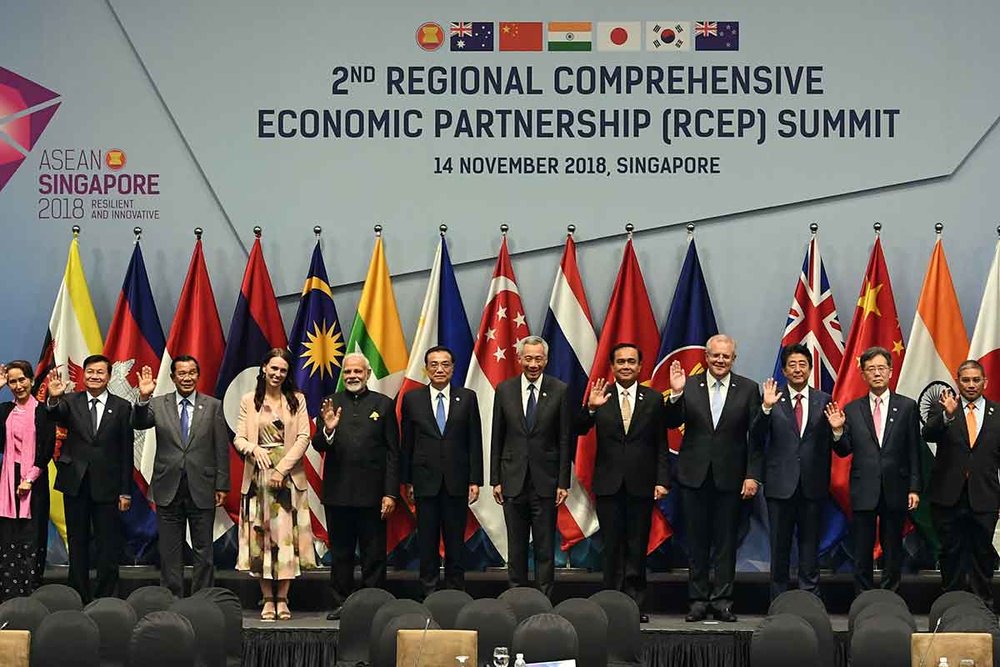The Regional Comprehensive Economic Partnership: A Worthwhile Commitment

Written by: Adithi sANJAY
published on: sunday, february 10, 2019.
Last November saw the conclusion of the Second Regional Comprehensive Economic Partnership (RCEP) Summit in Singapore. The RCEP is a proposed Free Trade Agreement (FTA) between the 10 ASEAN members and six other countries: Japan, China, South Korea, India, Australia, New Zealand. Negotiations began in 2011, and when the deal is eventually finalized, the RCEP will account for 30% of the world’s GDP, as well as approximately 50% of the global population, making it the biggest trade deal since the upgrading of the General Agreement on Tariffs and Trade (GATT). The deal intends to cover goods, services, investment, economic and technological cooperation, competition, and intellectual property rights, and it has grown significantly in importance since the US’s withdrawal from the Trans-Pacific Partnership (TPP) in 2017. The ASEAN+6 countries, however, failed to reach agreement on the areas of e-commerce, competition, and investment during the latest round of negotiations, and thus, leaders have decided to push final negotiations to 2019. Prime Minister Modi resisted significant pressure to sign the deal last November, and it is thus unclear whether or not India will choose to participate in the monumental trade deal.
Modi’s resistance to the deal is partly attributable to the fact that India will go to the polls later this year, and thus the Prime Minister’s 2014 campaign promises are under significant scrutiny. As a result, the Central Government’s current agenda is focused on protecting Indian entities and “developing India into a manufacturing hub,” both key tenets of Modi’s “Make in India” campaign. Furthermore, Modi’s reluctance is also attributable to India’s trade deficit which has already grown to 2.8% of GDP, and NITI Aayog’s recent report that India’s trade deficit with RCEP countries has risen from $9 billion in 2004-05 to over $80 billion today. Given that joining the RCEP would involve committing to the progressive elimination of tariff and non-tariff barriers, certain officials argue that signing the deal likely would not reduce the deficit. In the same vein, there are concerns that signing the RCEP would inherently bring with it the risk of an influx of cheap imports, which would directly impact “steel plastics, copper, aluminium, machine tools, chemicals, textiles and pharma” industries. The Indian steel industry in particular has criticized existing free trade agreements (FTAs) that India currently holds with Korea and Japan, arguing that ASEAN exports to India have grown much faster than Indian exports to the trading bloc, and the prospect of India agreeing to zero tariffs on steel imports is dangerous. Moreover, the Indian agriculture industry has reservations about the implications of RCEP primarily because Australia and New Zealand are both large exporters of agri-products and opening up Indian agricultural markets to them may damage the Indian agricultural sector.
However, despite the aforementioned concerns regarding the potential negative implications of India joining the RCEP, it is clear that the nation needs the network of production and trade that the group would provide, particularly if Modi is to create the manufacturing jobs necessary for Indian economic growth. India cannot find itself excluded from regional trade chains, and given that the RCEP would grant members preferential access to international markets through the reduction of trade barriers, withdrawing from negotiations would cause Indian exports to become far less competitive than they are at present. Furthermore, based on an examination of the mechanics of Intra-Industry Trade (IIT) in the context of India joining the RCEP, Dr. Ram Upendra Das and Jay Dev Dubey, academics at the New-Delhi based independent policy institute Research and Information System For Developing Countries, highlight the fact that the agreement would result in greater goods integration, which would in turn generate and sustain greater IIT trade flows, significantly benefiting the Indian economy. Moreover, the common set of rules and regulations that the RCEP would establish across the 16 nations involved would make India more attractive to multinational corporations. Common regulations would also increase opportunities for cross-border investment, allow the frictionless movement of labor, and grant India preferential access to new export markets.
Furthermore, joining the RCEP would complement and strengthen Modi’s “Act East” policy, a modified form of the “Look East” policy adopted by Narasimha Rao in the 1990s, which had the goal of “broadening and deepening India’s ties in the region and positioning it as a key strategic player in the Asia-Pacific.” Despite the fact that India is currently one of Asia’s largest economies, the nation is currently not a member of the Asia-Pacific Economic Cooperation (APEC). Given that India has had the desire to join APEC for the past two decades, joining the RCEP would present the country with the opportunity to reaffirm its commitment to strengthening ties with Asia and encourage the international community to expand its regional focus and admit India as a new member. As RCEP negotiations continue into 2019, concerns about the 2019 Indian General election will certainly take center stage. However, given that the benefits of joining the trade deal certainly outweigh the potential risks involved, Prime Minister Modi must cooperate with the international community in order to negotiate favorable terms for India’s participation in the RCEP and prioritize the nation’s long-term economic welfare over his desire to protect Indian industries for short-term political gain ahead of the 2019 general elections.